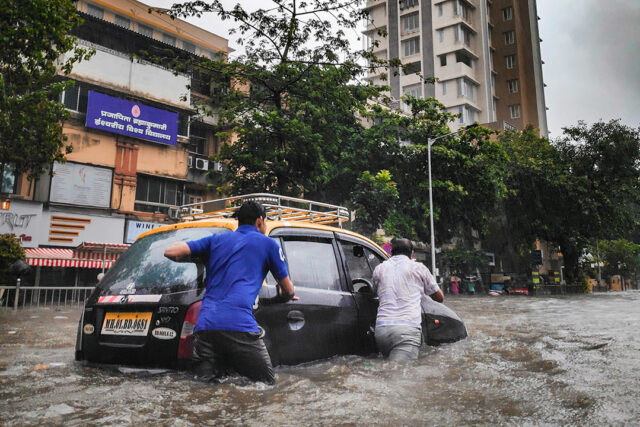JERUSALEM/BEIRUT — US President Joseph R. Biden and Israeli Prime Minister Benjamin Netanyahu spoke on Wednesday about potential Israeli retaliation against Iran while Lebanon’s Hezbollah said its fighters pushed back advancing Israeli forces along the border.
The ground clashes, which are spreading along southern Lebanon’s mountainous frontier with Israel, took place with the Gaza war still raging and the Middle East on high alert awaiting Israel’s response to Iran’s missile strike last week.
Tehran lashed out over Israel’s escalation in Lebanon, which is aimed at degrading Iran-backed armed group Hezbollah.
Mr. Biden and Mr. Netanyahu talked about Israel’s plans in a call that lasted 30 minutes, the White House said.
The discussion was “direct and very productive,” White House Press Secretary Karine Jean-Pierre told reporters, while acknowledging the two leaders have disagreements and are open about them.
Mr. Netanyahu’s office confirmed the call without giving any immediate details on what was discussed. Israel’s UN Ambassador Danny Danon told reporters the two leaders held “a positive call, and we appreciate the support of the US.”
The pair agreed to remain in close contact in the coming days and Mr. Biden urged Mr. Netanyahu to minimize civilian harm in Lebanon, the White House said later.
Mr. Biden again condemned Iran’s attack on Israel, urged renewed diplomacy on Gaza and affirmed Israel’s right to defend itself against Hezbollah, the White House said.
Relations between Mr. Biden and Mr. Netanyahu have been tense over the Israeli leader’s handling of Gaza and Lebanon. The US has tried to prevent hostilities from escalating and has unsuccessfully sought to broker a ceasefire in Israel’s year-old war in Gaza against Hamas, which is also backed by Iran.
Israel has promised that arch-foe Iran will pay for its missile attack, which caused little damage, while Tehran has said any retaliation would be met with vast destruction, raising fears of a wider war in the oil-producing region that could draw in the United States.
Mr. Biden last week made comments discouraging Israel from striking Iranian oil fields and said he would not support Israel striking Iranian nuclear sites.
Israeli Defense Minister Yoav Gallant had been due to meet with his US counterpart in Washington on Wednesday, and Israeli media reports said the objective was to strengthen coordination on Iran.
But Mr. Gallant cancelled the visit as the reports said Netanyahu had set preconditions including holding the call with Mr. Biden, their first since August.
Some analysts say Israel is most likely to respond to Iran’s Oct. 1 attack by targeting Iranian military installations, especially those that produce ballistic missiles like those used in the attack. It could also seek to destroy Iranian air defense systems and missile-launching facilities.
In a video carried by Israeli media on Wednesday, Mr. Gallant reiterated plans for a lethal strike against Iran. “Our attack will be deadly, precise and above all surprising,” he said.
HEZBOLLAH PUSHES BACK ISRAELI TROOPS
Hezbollah said its fighters had fired several rocket salvoes at Israeli troops near the village of Labbouneh in the western part of the border area, close to the Mediterranean coast, and had managed to push them back. Hezbollah has been launching rockets against Israel for a year in support of Hamas in its conflict with Israel in Gaza.
Further east, Hezbollah said it had attacked Israeli soldiers in the village of Maroun el-Ras and unleashed missile barrages at Israeli forces advancing towards the twin border villages of Mays al-Jabal and Mouhaybib.
Video posted on social media showed three Israeli soldiers raising their country’s blue and white flag in Maroun el-Ras, the first time in decades they are known to have done so on Lebanese territory Israel occupied from 1982 to 2000. Reuters confirmed the location based on visible geographic features.
Amin Sherri, a Hezbollah politician visiting displaced people in schools in Beirut on Wednesday, told reporters that Israeli forces had not been able to achieve their military aims and the Israeli flag raised in the south was up only briefly.
Rocket sirens sounded constantly across northern Israel, including in the major port city of Haifa, following heavy fire from Lebanon. Israel’s military said about 40 projectiles were launched in one barrage at Haifa, some of which were intercepted while others fell in the area.
Israeli ambulance workers said two people were killed in strikes on Kiryat Shmona near the border and at least six were wounded in Haifa.
Israel, meanwhile, launched airstrikes including at targets far from the border combat zone. The Lebanese health ministry said four people were killed and 10 wounded by a strike in the town of Wardaniyeh, north of Sidon along the coast.
Although the conflict has intensified, a proposal last month by the US and France for a 21-day truce between Israel and Hezbollah “is still on the table,” the top UN official in Lebanon said on Wednesday. Israel snubbed the idea at the time, but UN Special Coordinator for Lebanon Jeanine Hennis-Plasschaert told reporters via video from Beirut that it was still “very relevant, so we should not dismiss it.”
Israel’s bombardment of Lebanon has killed more than 2,100 people, most of them in the last few weeks, and forced 1.2 million from their homes. Israel says it has no choice but to strike Hezbollah so that tens of thousands of Israelis can return to homes they fled under Hezbollah rocket fire. — Reuters








 Key highlights of the event included sharing of insights on the latest digital trends and strategies, equipping participants with valuable information for informed decision-making. The session was followed by personalized consultations offering customized guidance and recommendations based on each business’s specific needs and objectives. Participants left the event with actionable plans to address their most pressing challenges and capitalize on emerging opportunities.
Key highlights of the event included sharing of insights on the latest digital trends and strategies, equipping participants with valuable information for informed decision-making. The session was followed by personalized consultations offering customized guidance and recommendations based on each business’s specific needs and objectives. Participants left the event with actionable plans to address their most pressing challenges and capitalize on emerging opportunities.








